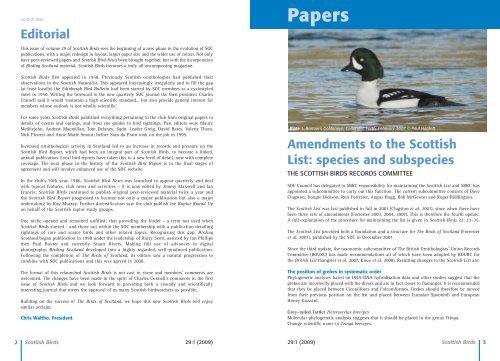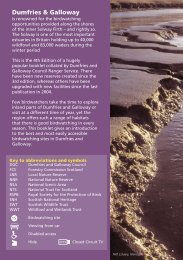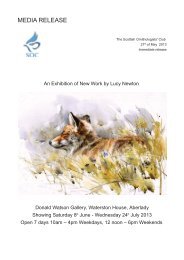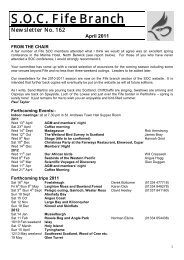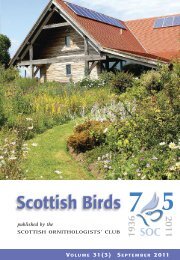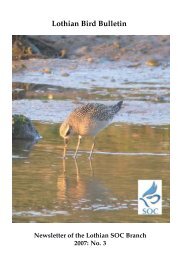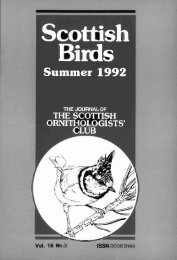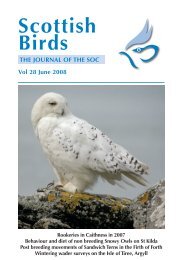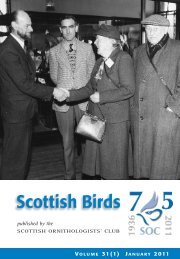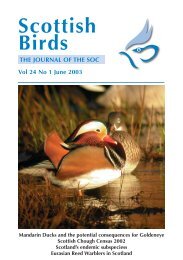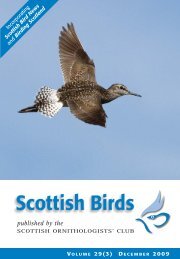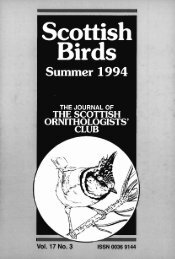*SCOTTISH BIRDS (29) TXT AW - The Scottish Ornithologists' Club
*SCOTTISH BIRDS (29) TXT AW - The Scottish Ornithologists' Club
*SCOTTISH BIRDS (29) TXT AW - The Scottish Ornithologists' Club
Create successful ePaper yourself
Turn your PDF publications into a flip-book with our unique Google optimized e-Paper software.
<strong>Scottish</strong> BirdsEditorialThis issue of volume <strong>29</strong> of <strong>Scottish</strong> Birds sees the beginning of a new phase in the evolution of SOCpublications, with a major redesign in layout, larger paper size and the wider use of colour. Not onlyhave peer-reviewed papers and <strong>Scottish</strong> Bird News been brought together, but with the incorporationof Birding Scotland material, <strong>Scottish</strong> Birds becomes a truly all-encompassing magazine.<strong>Scottish</strong> Birds first appeared in 1958. Previously <strong>Scottish</strong> ornithologists had published theirobservations in the <strong>Scottish</strong> Naturalist. This appeared increasingly irregularly and to fill the gap(at least locally) the Edinburgh Bird Bulletin had been started by SOC members as a cyclostyledsheet in 1950. Writing the foreword to the new quarterly SOC journal the then president CharlesConnell said it would ‘maintain a high scientific standard… but also provide general interest formembers whose outlook is not wholly scientific.’PapersPapersFor some years <strong>Scottish</strong> Birds published everything pertaining to the club from original papers todetails of events and outings, and from site guides to bird sightings. Past editors were MauryMeiklejohn, Andrew Macmillan, Tom Delaney, Sqdn. Leader Greig, David Bates, Valerie Thom,Nick Picozzi and Anne-Marie Smout; before Stan da Prato took on the job in 1995.Increased ornithological activity in Scotland led to an increase in records and pressure on the<strong>Scottish</strong> Bird Report, which had been an integral part of <strong>Scottish</strong> Birds, to become a linked,annual publication. Local bird reports have taken this to a new level of detail, now with completecoverage. <strong>The</strong> next phase in the history of the <strong>Scottish</strong> Bird Report is in the final stages ofagreement and will involve enhanced use of the SOC website.In the club’s 50th year, 1986, <strong>Scottish</strong> Bird News was launched to appear quarterly and dealwith topical features, club news and activities – it is now edited by Jimmy Maxwell and IanFrancis; <strong>Scottish</strong> Birds continued to publish original peer-reviewed material twice a year andthe <strong>Scottish</strong> Bird Report progressed to become not only a major publication but also a majorundertaking by Ray Murray. Further diversification saw the club publish the Raptor Round Upon behalf of the <strong>Scottish</strong> raptor study groups.One niche opened and remained unfilled; that providing the birder - a term not used when<strong>Scottish</strong> Birds started - and those not within the SOC membership with a publication detailingsightings of rare and scarce birds and other related topics. Recognising this gap, BirdingScotland began publication in 1998 under the leadership of Harry Scott, assisted by Ian Phillipsthen Paul Baxter and currently Stuart Rivers. Making full use of advances in digitalphotography, Birding Scotland developed into a highly regarded, well-produced publication.Following the completion of <strong>The</strong> Birds of Scotland, its editors saw a natural progression tocombine with SOC publications and this was agreed in 2008.<strong>The</strong> format of this relaunched <strong>Scottish</strong> Birds is not cast in stone and members’ comments arewelcomed. <strong>The</strong> changes have been made in the spirit of Charles Connell’s comments in the firstissue of <strong>Scottish</strong> Birds and we look forward to providing both a visually and scientificallyinteresting journal that meets the approval of as many <strong>Scottish</strong> birdwatchers as possible.Building on the success of <strong>The</strong> Birds of Scotland, we hope this new <strong>Scottish</strong> Birds will enjoysimilar acclaim.Chris Waltho, PresidentPlate 1. Barrow’s Goldeneye, Callander, Forth, February 2007 © Paul Hackett.Amendments to the <strong>Scottish</strong>List: species and subspeciesTHE SCOTTISH <strong>BIRDS</strong> RECORDS COMMITTEESOC Council has delegated to SBRC responsibility for maintaining the <strong>Scottish</strong> List and SBRC hasappointed a subcommittee to carry out this function. <strong>The</strong> current subcommittee consists of DaveClugston, Dougie Dickson, Ron Forrester, Angus Hogg, Bob McGowan and Roger Riddington.<strong>The</strong> <strong>Scottish</strong> List was last published in full in 2001 (Clugston et al. 2001), since when there havebeen three sets of amendments (Forrester 2003, 2004, 2007). This is therefore the fourth update.A full explanation of the procedure for maintaining the list is given in <strong>Scottish</strong> Birds 22: 33–35.<strong>The</strong> <strong>Scottish</strong> List provided both a foundation and a structure for <strong>The</strong> Birds of Scotland (Forresteret al. 2007), published by the SOC in December 2007.Since the third update, the taxonomic subcommittee of <strong>The</strong> British Ornithologists’ Union RecordsCommittee (BOURC) has made recommendations all of which have been adopted by BOURC forthe British List (Sangster et al. 2007, Knox et al. 2008). Resulting changes to the <strong>Scottish</strong> List are:<strong>The</strong> position of grebes in systematic orderPhylogenetic analyses based on DNA-DNA hybridisation data and other studies suggest that thegrebes are incorrectly placed with the divers and are in fact closer to flamingos. It is recommendedthat they be placed between Ciconiifores and Falconiformes. Grebes should therefore be movedfrom their previous position on the list and placed between Eurasian Spoonbill and EuropeanHoney-buzzard.Grey-tailed Tattler Heteroscelus brevipesMolecular phylogenetic analysis suggests that it should be placed in the genus Tringa.Change scientific name to Tringa brevipes.2<strong>Scottish</strong> Birds <strong>29</strong>:1 (2009) <strong>29</strong>:1 (2009)<strong>Scottish</strong> Birds 3


